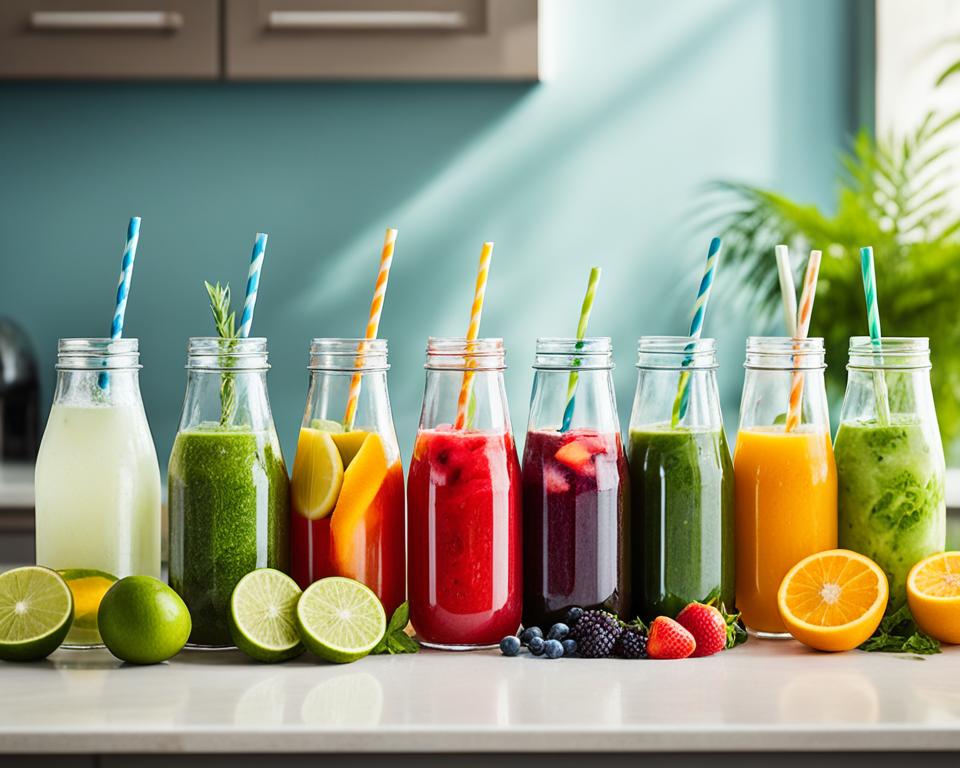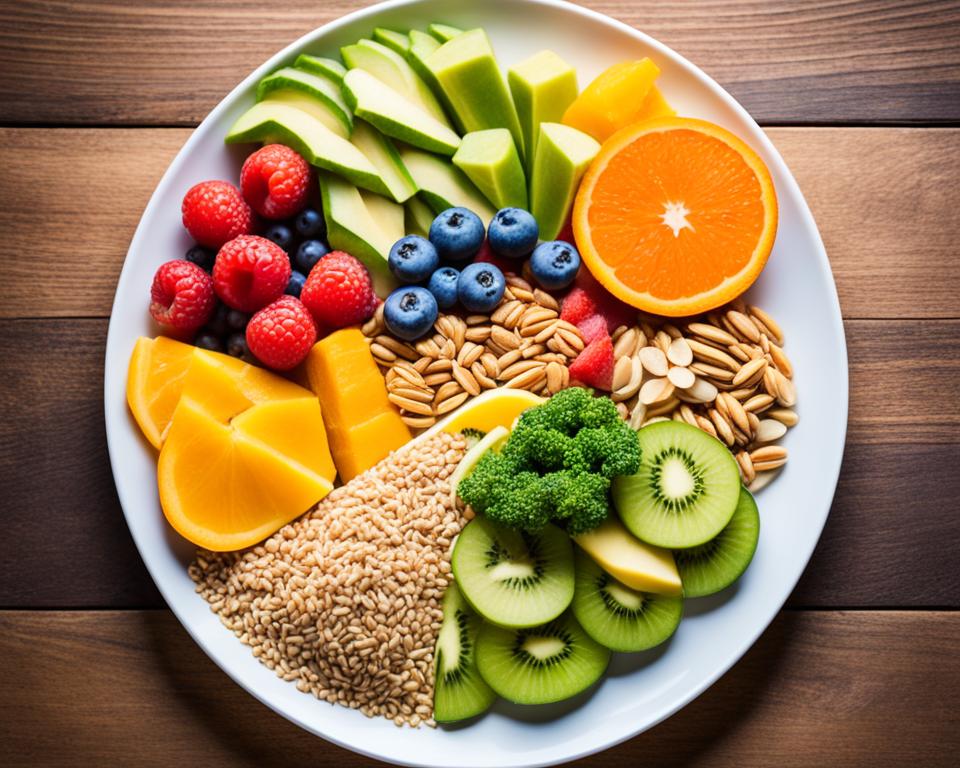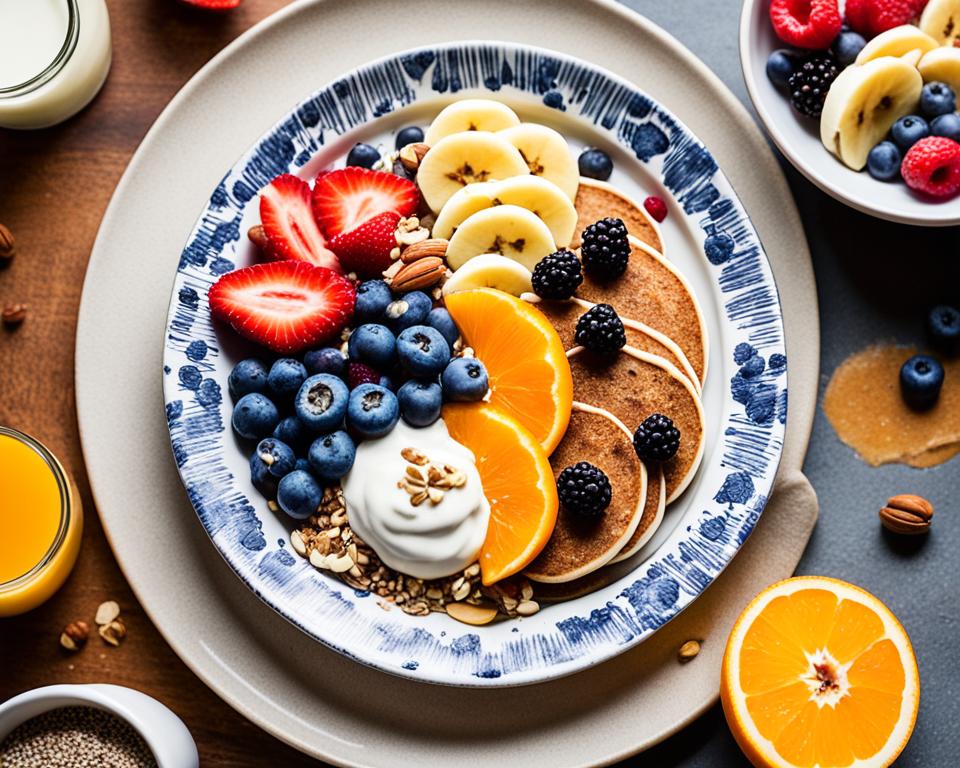Are you looking to enhance your nutrition and embrace a healthier lifestyle? Balanced meal planning is the key to achieving a nutritious diet that meets your individual needs. Whether you are a busy professional, a parent, or someone who wants to make positive changes to your eating habits, meal planning can help you stay on track and make healthier choices.
When it comes to meal planning, it doesn’t have to be complicated or time-consuming. By following a few simple steps, such as creating basic meal constructs, making a shopping list, and preparing food ahead of time, you can save both time and effort in the kitchen. Moreover, tailored meal prep recipes and essential nutrition tips can ensure that your meals are not only delicious but also packed with the right nutrients.
Key Takeaways:
- Balanced meal planning is vital for achieving a nutritious diet and healthier living.
- Meal planning doesn’t have to be complicated; a few simple steps can make a big difference.
- Tailored meal prep recipes and essential nutrition tips can help you create meals that align with your taste preferences and nutrition needs.
- Meal planning saves time and effort in the kitchen while ensuring that you consume a balanced diet.
- Regularly reviewing and adjusting your meal plan based on your goals and lifestyle is essential for long-term success.
Benefits of Balanced Meal Planning
Incorporating balanced meal planning into your routine offers numerous benefits that can positively impact your health and lifestyle. Meal planning not only helps you stay on track with your nutrition goals but also saves you time, money, and reduces food waste.
Nutrition Goals and Balanced Diet
By prepping and planning your meals, you can ensure that you’re consuming a balanced diet tailored to your specific nutrition needs. Meal planning allows you to strategically incorporate all the essential food groups, including vegetables, fruits, whole grains, lean proteins, and healthy fats, ensuring you receive the necessary nutrients for optimal health.
Save Time and Money
Easy meal planning can be a time-saver in your busy schedule. By dedicating a specific time to plan your meals and prepare in advance, you can streamline your cooking process and eliminate the stress of deciding what to eat each day. This allows you to make efficient use of your time and ensures you always have nutritious meals readily available.
Additionally, adhering to a meal plan and shopping list helps you make strategic choices while grocery shopping, saving you money in the long run. By purchasing only the items you need for your planned meals, you can avoid unnecessary impulse purchases and reduce food waste. This not only benefits your wallet but also contributes to a more sustainable environment.
Control Over Food Choices and Healthier Habits
Meal planning gives you more control over your food choices, allowing you to make intentional decisions that align with your health and wellness goals. It helps you avoid impulsive and unhealthy food choices, keeping you accountable and on track with your nutrition plan.
By consistently following a meal plan, you can develop healthier eating habits over time. Planning and preparing your meals in advance promote mindful eating, portion control, and the consumption of whole, nutrient-dense foods. This creates a foundation for long-term healthy eating patterns that can support your overall well-being.
Meal planning not only helps you stay on track with your nutrition goals but also saves you time, money, and reduces food waste.
Customizing Your Meal Plan
When it comes to meal planning, customization is key. Your meal plan should be tailored to your individual needs and preferences, taking into account factors such as your nutrition needs, taste preferences, cooking abilities, medical conditions, and budget. By personalizing your meal plan, you can ensure that it aligns with your unique circumstances and supports your overall well-being.
Consider Your Nutrition Needs
One of the first things to consider when customizing your meal plan is your nutrition needs. This includes determining your daily calorie intake, macronutrient distribution, and any specific dietary requirements you may have. For example, if you’re trying to increase your protein intake for muscle building or have specific nutrient deficiencies, you can adjust your meal plan accordingly.
Take Your Taste Preferences into Account
Eating meals you enjoy is essential for long-term adherence to a meal plan. Take your taste preferences into account when customizing your meals. For instance, if you don’t enjoy certain vegetables, find alternative options that provide similar nutrients. Experiment with different flavors, seasonings, and cooking techniques to make your meals more enjoyable.
Consider Your Cooking Ability
Another important factor to consider is your cooking ability. If you’re a beginner in the kitchen, opt for simple recipes with basic cooking techniques. As you become more comfortable and skilled, you can gradually incorporate more complex recipes into your meal plan. Additionally, consider the time you have available for cooking and meal preparation. Choose recipes that fit your schedule and lifestyle.
Account for Medical Conditions
If you have any medical conditions or dietary restrictions, be sure to account for them when customizing your meal plan. For example, if you have diabetes, you may need to focus on recipes that are low in added sugars and carbohydrates. If you have gluten intolerance or celiac disease, you’ll want to choose gluten-free options. Consulting with a registered dietitian can provide valuable guidance in creating a meal plan that accommodates your specific medical needs.
Budget-Friendly Choices
Lastly, consider your budget when customizing your meal plan. Eating healthy doesn’t have to break the bank. Plan your meals around affordable yet nutritious ingredients. Incorporate seasonal fruits and vegetables, use pantry staples, and look for sales or discounts on protein sources. By being mindful of your budget, you can create a meal plan that is not only nutritious but also cost-effective.
Customizing your meal plan allows you to create a personalized approach to healthy eating. By taking into account your nutrition needs, taste preferences, cooking abilities, medical conditions, and budget, you can create a meal plan that meets your unique needs and supports your overall well-being.
The Components of a Healthy Diet
A healthy, balanced diet consists of various components. These include vegetables, fruits, whole grains, lean proteins, and healthy fats.
Aim to fill half of your plate with vegetables, including cruciferous veggies like broccoli and leafy greens. These nutrient-rich powerhouses provide vitamins, minerals, and fiber that contribute to overall health.
Choose a variety of colorful fruits to add natural sweetness to your meals. From berries bursting with antioxidants to tropical fruits rich in vitamin C, incorporating a rainbow of fruits ensures a wide array of essential nutrients.
Incorporate whole grains such as brown rice and whole wheat bread for added fiber and nutrients. These complex carbohydrates provide sustained energy and contribute to feelings of fullness.
Opt for lean proteins like grilled chicken, ground turkey, and white fish to meet your body’s protein needs. These protein sources are low in saturated fats and provide essential amino acids for muscle repair and growth.
Finally, include healthy fats from sources like fatty fish, nuts, and avocados for essential nutrients. These fats, including omega-3 fatty acids, play a crucial role in heart health and can aid in the absorption of fat-soluble vitamins.
By incorporating these key components into your diet, you can create a foundation of nourishment that supports overall health and well-being.
Planning a Daily Menu
Planning a daily menu is an effective way to ensure that each meal and snack you consume provides a balanced combination of essential macronutrients. By including protein, fiber, complex carbohydrates, and a moderate amount of fat in each meal, you can maintain steady energy levels and meet your nutrition goals.
Key Macronutrients to Include
When planning your daily menu, it’s important to prioritize foods that provide the following essential macronutrients:
- Protein: Choose lean sources of protein such as chicken, fish, tofu, or beans, as they are rich in amino acids and support muscle growth and repair.
- Fiber: Include high-fiber foods like vegetables, fruits, whole grains, and legumes to promote digestion, enhance satiety, and support overall gut health.
- Complex Carbohydrates: Opt for complex carbohydrates such as quinoa, brown rice, sweet potatoes, and whole wheat bread, as they provide sustained energy and are rich in essential vitamins and minerals.
- Fat: Incorporate healthy fats from sources like avocados, nuts, seeds, and olive oil, as they are important for nutrient absorption, hormone production, and brain health.
By ensuring that your meals and snacks contain a balance of these macronutrients, you can optimize your nutrient intake and support your overall well-being.
Calorie Guidelines
While calorie needs may vary based on individual factors such as age, gender, activity level, and goals, a general guideline for daily calorie intake is to allocate approximately 100-250 calories for snacks and 300-600 calories per meal.
Keep in mind that these are approximate values and should be adjusted according to your specific needs and preferences. Consulting a healthcare professional or registered dietitian can provide personalized guidance and help refine your daily calorie targets.
Example Daily Menu
| Meal | Protein Source | Fiber Source | Complex Carbohydrate Source | Fat Source |
|---|---|---|---|---|
| Breakfast | Scrambled eggs | Spinach | Whole wheat toast | Avocado |
| Snack | Greek yogurt | Blueberries | Almonds | Peanut butter |
| Lunch | Grilled chicken | Mixed greens | Quinoa | Extra virgin olive oil |
| Snack | Cottage cheese | Carrot sticks | Whole grain crackers | Hummus |
| Dinner | Salmon | Roasted Brussels sprouts | Brown rice | Walnuts |
| Snack | Hard-boiled eggs | Celery sticks | Whole grain bread | Tahini |
This sample daily menu provides a combination of different macronutrients, ensuring a balance of protein, fiber, complex carbohydrates, and healthy fats throughout the day. However, it is essential to personalize your menu based on your specific dietary needs, taste preferences, and calorie goals.
Remember to consult with a registered dietitian or healthcare professional for personalized guidance in planning a daily menu that aligns with your nutrition goals.
Sample Meal Plan: 1-Week Healthy and Balanced Meal Plan
Here is a sample 1-week meal plan that provides a balance of calories and macronutrients. This plan is designed for a person who needs about 2,000-2,200 calories per day and has no dietary restrictions. It includes three meals and three snacks per day, with a focus on whole foods and nutrient balance. However, it’s important to note that individual calorie needs may vary, so it’s best to consult with a registered dietitian or healthcare provider to customize a meal plan based on your specific needs and goals.
| Meal | Time | Menu |
|---|---|---|
| Breakfast | 8:00 AM |
|
| 10:00 AM |
|
|
| Lunch | 12:00 PM |
|
| 3:00 PM |
|
|
| Dinner | 6:00 PM |
|
| Snacks | 10:00 AM |
|
| 3:00 PM |
|
Hydration and Beverages
Along with meal planning, it’s essential to consider hydration and beverage choices. Staying hydrated is crucial for overall health and well-being. Experts generally recommend drinking approximately 9 cups of water per day for women and 13 cups for men, although individual needs may vary depending on factors like age, activity level, and climate.
Proper hydration helps maintain bodily functions, regulate body temperature, and support digestion. It also plays a vital role in nutrient transportation and overall cellular health. To meet your fluid needs, it’s important to incorporate water and other hydrating beverages into your daily routine.
Avoiding dehydration is especially important when engaging in physical activity or spending time outdoors in hot weather. During these times, you may need to increase your fluid intake to compensate for sweat loss and ensure adequate hydration.
Importance of Limiting Sugar-Sweetened Beverages
When planning your meals, be mindful of the calorie content and nutritional value of beverages. Many popular drinks, such as soda, sports drinks, and sweetened fruit juices, are high in added sugars. These sugar-sweetened beverages can contribute to weight gain, tooth decay, and an increased risk of chronic diseases like type 2 diabetes and heart disease.
To maintain a balanced and healthy diet, aim to reduce or eliminate the consumption of sugar-sweetened beverages. Instead, focus on hydrating options that provide essential nutrients without the added sugars.
Water is the best choice for staying hydrated, as it has zero calories, no added sugars, and helps flush out toxins from the body. Additionally, herbal teas and flavored water can provide a refreshing alternative to plain water without the extra calories or sugar content.
Coffee and tea, when consumed without excessive added sugars, can also be part of a healthy beverage routine. Just be mindful of portion sizes and avoid excessive creamers or sweeteners that can significantly increase calorie and sugar intake.
Recommended Beverage Choices
Here are some recommended beverage choices to incorporate into your daily hydration routine:
- Water: The best option for hydration, calorie-free, and essential for overall health.
- Herbal teas: Refreshing and hydrating, with a variety of flavors to choose from.
- Flavored water: Infuse water with fresh fruits or herbs for a burst of natural flavor.
- Coffee and tea: Enjoy without excessive added sugar and creamers; moderation is key.
By being mindful of your beverage choices and prioritizing hydration with these healthier options, you can support a balanced and nutritious diet.
| Beverage | Calories (per 8-ounce serving) | Sugar (per 8-ounce serving) |
|---|---|---|
| Water | 0 | 0 |
| Herbal Tea | 0 | 0 |
| Flavored Water (no added sugar) | 0 | 0 |
| Black Coffee (no added sugar) | 2 | 0 |
| Green Tea (unsweetened) | 2 | 0 |
| Unsweetened Almond Milk | 30 | 0 |
| Skim Milk | 83 | 12 |
| Orange Juice (no added sugar) | 112 | 20 |
| Soda (regular) | 150 | 39 |
| Sweetened Iced Tea | 140 | 36 |
| Fruit Punch | 50 | 13 |
Table: Comparison of calorie and sugar content in different beverages (per 8-ounce serving).

Meal Plan for Weight Loss
If your goal is weight loss, it’s essential to create a meal plan tailored to your needs. By making simple adjustments to your calorie intake and focusing on portion control, you can achieve a healthy and sustainable weight loss.
To effectively lose weight, aim to reduce your daily calorie intake by 500-750 calories. This calorie reduction creates a calorie deficit, which prompts your body to burn stored fat for energy. However, it’s important to consult with a healthcare professional or registered dietitian before making significant changes to your diet.
Portion control is key when it comes to weight loss. By monitoring your portion sizes, you can ensure that you’re consuming an appropriate amount of calories for your goals. Be mindful of serving sizes and use measuring cups or a food scale to accurately gauge your portions.
When planning your meals, focus on choosing lower calorie options that are still nutrient-rich. Opt for lean proteins like chicken, turkey, fish, or plant-based alternatives. These protein sources can help you feel satisfied while supporting muscle growth and repair.
Include plenty of fruits and vegetables in your meals to add volume and fiber without adding excessive calories. Opt for whole grains like quinoa, brown rice, or whole wheat bread to provide complex carbohydrates that keep you energized throughout the day.
Healthy fats are also important in a well-rounded meal plan. Include sources such as avocado, nuts, seeds, and olive oil to provide essential nutrients and promote satiety.
Sample 1-Day Weight Loss Meal Plan
| Meal | Food Choices |
|---|---|
| Breakfast | Scrambled egg whites with spinach and tomatoes Whole wheat toast Fresh berries |
| Lunch | Grilled chicken salad with mixed greens, cucumber, and bell peppers Balsamic vinaigrette dressing Steamed broccoli |
| Snack | Greek yogurt with sliced almonds and a sprinkle of cinnamon |
| Dinner | Baked salmon with lemon and dill Quinoa pilaf with vegetables Roasted asparagus |
| Snack | Carrot sticks with hummus |
This sample 1-day meal plan provides a balanced approach to weight loss. It includes nutrient-dense foods and controlled portions to support calorie reduction while maintaining essential nutrition.
Remember, individual calorie needs may vary based on factors such as gender, age, activity level, and overall health. It’s crucial to consult with a healthcare professional or registered dietitian to develop a personalized weight loss meal plan that aligns with your specific needs and goals.
Creating a Healthy Eating Plan
The key to a healthy eating plan is to consume a variety of nutrient-packed foods that meet your calorie needs. By incorporating a wide range of fruits, vegetables, whole grains, lean proteins, and healthy fats into your meals, you can ensure that your body receives essential nutrition. It’s important to be mindful of portion sizes and choose foods that are high in nutrients while being low in added sugars, saturated fats, and sodium.
If you need guidance in creating a healthy eating plan, consider consulting with a registered dietitian. They can provide you with personalized advice and recommendations based on your specific needs and goals. Additionally, you can utilize resources like the Healthy Eating Plate from Harvard University for valuable information on building a balanced and nutritious diet.

Incorporating a variety of nutrient-packed foods into your meals offers a multitude of health benefits. Fruits and vegetables provide essential vitamins, minerals, and antioxidants that support overall well-being. Whole grains are rich in fiber and can help maintain a healthy digestive system. Lean proteins supply the body with necessary amino acids, while healthy fats contribute to heart health and provide energy. By focusing on these nutrient-dense foods, you can fuel your body with the necessary building blocks for optimal health.
Creating a healthy eating plan also involves being aware of your calorie needs. Calorie intake varies depending on factors such as age, gender, activity level, and overall health. It’s crucial to ensure that your calorie consumption aligns with your individual requirements to maintain a healthy weight and energy balance.
The Healthy Eating Plate
The Healthy Eating Plate is a guide developed by Harvard University that promotes balanced meals and considers the impact of food choices on both personal health and the environment. It emphasizes the importance of vegetables, fruits, whole grains, healthy proteins, water, and healthy oils in creating nutritious and sustainable meals.
By following the recommendations of the Healthy Eating Plate, individuals can make informed choices that support their health and contribute to a more sustainable food system.
| Healthy Eating Plate | Nutrition Benefits | Environmental Impact |
|---|---|---|
| Vegetables | Provide essential vitamins, minerals, and fiber | Lower carbon footprint compared to animal-based foods |
| Fruits | Rich in antioxidants and natural sugars for energy | Less resource-intensive than processed sweets |
| Whole Grains | High in fiber and nutrients for sustained energy | Require less water and land compared to refined grains |
| Healthy Proteins | Provide essential amino acids for muscle growth and repair | Generate fewer greenhouse gas emissions than red meat |
| Water | Hydrates the body without added calories | Reduces the environmental impact of sugary beverages |
| Healthy Oils | Contain essential fatty acids for brain health | Require fewer resources to produce than saturated fats |
By incorporating these components into their meals, individuals can create balanced and nutrient-packed plates while considering the environmental impact of their food choices.
It’s important to note that the Healthy Eating Plate serves as a guide, and individual dietary needs and preferences may vary. Consulting with a registered dietitian can help tailor a meal plan that suits specific health goals and lifestyle factors.
Quote:
“The Healthy Eating Plate encourages individuals to prioritize plant-based foods and make mindful choices that benefit both personal health and the environment.” – Harvard University
By consciously selecting nutrient-rich foods and considering the consequences of our food choices on the environment, we can contribute to a healthier future for ourselves and the planet.
Creating a Sustainable Diet
In addition to considering personal health, it’s important to think about the environmental impact of our food choices. Food production is a significant contributor to greenhouse gases and places a heavy demand on natural resources. By adopting a sustainable diet, which includes consuming more plant-based foods, reducing food waste, and choosing environmentally friendly options, we can play a role in mitigating the environmental challenges we face. Individuals can make a difference by selecting locally sourced, organic, and seasonal foods whenever possible.
Conclusion
Balanced meal planning is an integral part of maintaining a nutritious diet and achieving optimal health. By taking into account individual preferences, nutrition needs, and lifestyle factors, individuals can create customized meal plans that support their overall well-being. Meal planning offers a range of benefits, including improved nutrient intake, time and money savings, and reduced food waste. By emphasizing a variety of nutrient-packed foods, practicing portion control, and prioritizing hydration, individuals can make significant progress in attaining a balanced and healthy diet.
With a well-designed meal plan, individuals can enjoy the health benefits associated with a nutritious and well-balanced diet. Adequate meal planning helps ensure that essential nutrients are incorporated into meals, addressing individual health needs and promoting vitality. By incorporating a diverse range of fruits, vegetables, whole grains, lean proteins, and healthy fats, individuals can provide their bodies with the necessary fuel for optimal function and disease prevention.
It is important to bear in mind that consulting with healthcare professionals or registered dietitians is crucial for personalized advice and guidance on meal planning. These experts can offer invaluable insights and recommendations based on an individual’s unique circumstances and health goals. By working with professionals in the field, individuals can fine-tune their meal planning strategies and optimize their journey towards a well-rounded and nutritious diet.
In conclusion, balanced meal planning is key to a healthy lifestyle and offers various health benefits. By taking the time to create a personalized meal plan that aligns with individual needs and preferences, individuals can ensure a well-balanced and nourishing diet. This approach promotes improved nutrient intake, helps save time and money, reduces food waste, and supports overall health and well-being. Embrace the power of meal planning and unlock the potential of a nutritious diet for a healthier and happier life.
FAQ
What is balanced meal planning?
Balanced meal planning involves creating a strategic plan for your meals and snacks to ensure you are consuming a variety of nutrient-dense foods that meet your nutritional needs.
What are the benefits of balanced meal planning?
Balanced meal planning offers several benefits, such as helping you stay on track with your nutrition goals, saving time and money, reducing food waste, and promoting healthier eating habits.
How can I customize my meal plan?
To customize your meal plan, consider factors such as your taste preferences, nutrition needs, cooking abilities, medical conditions, and budget. Tailor your plan to meet your individual circumstances and ensure it works best for you.
What should a healthy diet consist of?
A healthy diet should consist of vegetables, fruits, whole grains, lean proteins, and healthy fats. Aim to eat a variety of these components to get the necessary nutrients for optimal health.
How do I plan a daily menu?
Plan a daily menu by ensuring that each meal and snack contains a balance of protein, fiber, complex carbohydrates, and a moderate amount of fat. This will help maintain steady energy levels and meet your nutrition goals.
Can you provide a sample 1-week meal plan?
Yes, here is a sample 1-week meal plan that provides a balance of calories and macronutrients: [Insert Sample Meal Plan]. Remember to consult with a healthcare professional for personalized advice based on your specific needs and goals.
How important is hydration and beverage choice?
Hydration is crucial for overall health. Aim to drink approximately 9 cups of water per day for women and 13 cups for men. Consider the calorie content of beverages and choose water, tea, or coffee with little or no added sugar instead of sugar-sweetened drinks.
How should I plan my meals for weight loss?
To plan meals for weight loss, focus on portion control and choosing lower calorie options. Reduce your daily calorie intake by about 500-750 calories. Women generally aim for a meal plan of 1,200-1,500 calories per day, while men and active individuals may require 1,500-1,800 calories per day. Consult with a healthcare professional before making significant changes to your diet.
How can I create a healthy eating plan?
Create a healthy eating plan by incorporating a variety of nutrient-packed foods that meet your calorie needs. Focus on fruits, vegetables, whole grains, lean proteins, and healthy fats. Be mindful of portion sizes and choose foods low in added sugars, saturated fats, and sodium.
What is the Healthy Eating Plate?
The Healthy Eating Plate is a guide developed by Harvard University that promotes balanced meals and considers the impact of food choices on personal health and the environment. It emphasizes the importance of vegetables, fruits, whole grains, healthy proteins, water, and healthy oils in creating nutritious and sustainable meals.
How can I create a sustainable diet?
Creating a sustainable diet involves consuming more plant-based foods, reducing food waste, and choosing environmentally friendly options. Select locally sourced, organic, and seasonal foods whenever possible to reduce your environmental impact and contribute to a more sustainable food system.
What are the key points of balanced meal planning?
Balanced meal planning is essential for a nutritious diet. It offers benefits such as improved nutrient intake, time and money savings, and reduced food waste. By focusing on a variety of nutrient-dense foods, portion control, and hydration, individuals can achieve a balanced and healthy diet.





